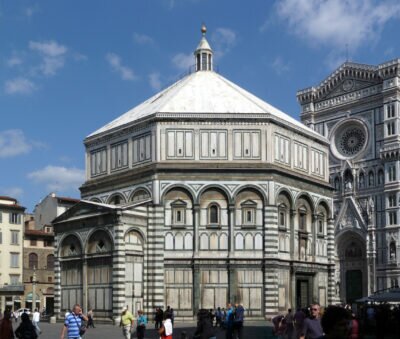After visiting the Duomo, the next port of call is the battistero (baptistery). In exile, Dante fondly referred to this building as his “bel San Giovanni” and described it as “ancient” – a word loaded with meaning. Florentines have always exaggerated its antiquity, asserting that it was originally the Temple of Mars, built by the Romans to commemorate victory over the Etruscan city of Fiesole. In the intercommunal rivalry of the Middle Ages, every Tuscan town claimed to be older than its neighbours, and the baptistery symbolised the Florentine pedigree, its link with the golden classical age.
⠀
All the evidence suggests that it was, in fact, built in the 6th or 7th century, albeit reusing Roman masonry. From the 12th century it was taken under the wing of the wool importers’ guild, which itself claimed to be the first and most ancient trade association in the city.
⠀
The guild paid for the beautiful marble cladding of green geometric designs on a white background. This was widely admired and imitated throughout Tuscany, the prototype of many a church exterior, including that of Florence’s own cathedral. The splendid interior was reworked between 1270 and 1300, when the dome received its ambitious cycle of mosaics – illustrating the entire biblical story from Creation to the Last Judgement – and the zodiac pavement around the font was laid.
⠀
Next, the guild turned to the entrances, determined to outdo the great bronze doors of Pisa cathedral. They did so, but not until several decades later. Andrea Pisano’s doors, now in the south portal, were completed in 1336, and the 28 panels show scenes from the life of San Giovanni (St John), the patron saint of the city, as well as allegoric themes of the Virtues. They are outstanding examples of the best Gothic craftsmanship, but it was Ghiberti’s north and east doors that really set Europe talking 60 years later.
⠀
Work stopped on the baptistery during the intervening period due to a series of disasters – including plague, appalling weather, crop failures and famine, as well as bankruptcies and further political turmoil in Florence.

